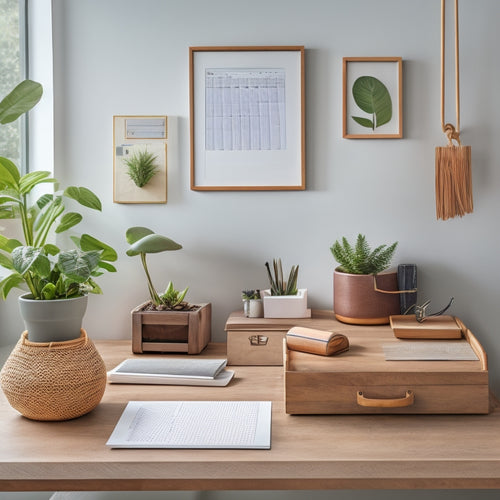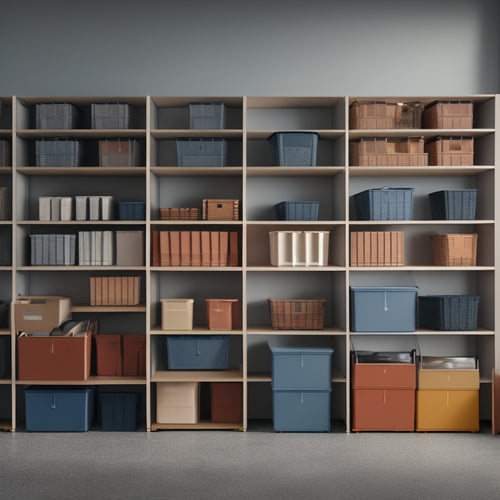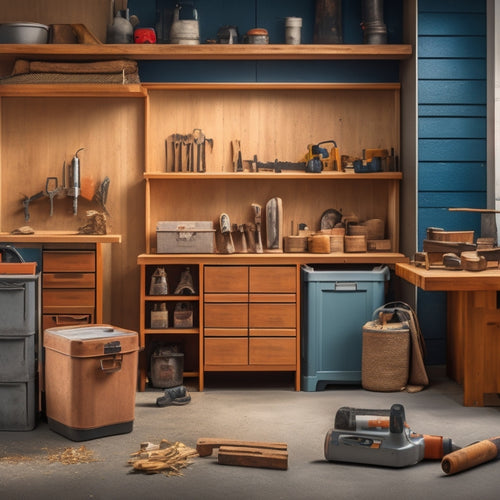
5 Essential Workshop Layout Ideas for Beginners
Share
You're about to transform your workshop into a productivity powerhouse with a layout that streamlines your workflow and boosts efficiency. Start by dividing your workshop into distinct zones, each with its own tool and material storage areas. Position tools and heavy equipment for easy access, and arrange stations in workflow sequence to maximize efficiency. Don't forget to utilize vertical storage space with shelves, cabinets, and pegboards. Prioritize lighting and ergonomics when designing your workbench, and create a logical sequence for workstations and tools to minimize congestion. Now, discover how to fine-tune these essentials to supercharge your workshop's performance.
Key Takeaways
• Divide the workshop into distinct zones with a color-coded organization system to enhance productivity and efficiency.
• Place tool storage units near tool stations to reduce walking distances and maximize workflow efficiency.
• Install shelves, cabinets, or pegboards up to the ceiling to maximize vertical storage space and keep frequently used tools accessible.
• Design workbenches with optimal tool accessibility, proper lighting, and ergonomic considerations to boost productivity and comfort.
• Create a logical sequence for workstations and tools to minimize backtracking, congestion, and improve navigation in the workshop.
Zone-Based Workshop Organization
Divide your workshop into distinct zones, each dedicated to a specific task or type of project, to create a functional and efficient workspace that helps you stay organized and focused. This zone-based approach allows you to categorize your tools and materials, making it easier to find what you need when you need it.
Implement a color-coded organization system, where each zone has its own designated color, to visually distinguish between areas. For instance, you can use yellow for woodworking, blue for metalworking, and red for electronics.
Within each zone, designate a specific area for tools and materials. Install a tool rack or tool cart to keep frequently used tools within easy reach. Label each tool and material storage area so you can quickly identify what's inside.
Optimizing Tool Station Placement
Once you've designated your zones, strategically place tool stations within each zone to maximize workflow efficiency and reduce walking distances between tasks. This will help you stay focused on the task at hand and avoid wasting time searching for tools or equipment.
Here are three key considerations to keep in mind when optimizing tool station placement:
-
Tool storage proximity: Place tool storage units, such as cabinets or chests, near the tool stations to make sure easy access to the tools you need.
-
Equipment accessibility: Position heavy or frequently used equipment in a way that allows for simple access and minimizes obstacles.
-
Workflow sequence: Arrange tool stations in the order you'll be using them to complete a task, reducing the need to backtrack or retrace your steps.
Maximizing Vertical Storage Space
To make the most of your workshop's vertical space, start by installing shelves, cabinets, or pegboards that go up to the ceiling, allowing you to store less frequently used items or bulky equipment out of the way. This will help keep your floor clear and give you more room to work.
Next, consider wall-mounted shelves or hanging tool racks to store smaller items like hand tools, accessories, or supplies. These will keep them organized and within easy reach.
For overhead storage, look into installing a pegboard or a slatwall with hooks and bins. This will enable you to store items like bikes, ladders, or infrequently used equipment, keeping them out of the way but still accessible.
Pegboard organization is also a great way to store tools and accessories, making them easy to find and use. By maximizing your vertical storage space, you'll be able to work more efficiently and have more room to focus on your projects.
Efficient Workbench Design Tips
What makes a workbench efficient, and how can you design one that streamlines your workflow and boosts productivity?
A well-designed workbench is essential to getting the most out of your workshop. Here are some key considerations to keep in mind:
-
Optimize tool accessibility: Place your most frequently used tools within easy reach to reduce walking distances and save time.
-
Prioritize lighting placement: Position lighting sources to minimize shadows and glare, ensuring you can see your work clearly.
-
Balance space utilization and ergonomic considerations: Design your workbench to accommodate your body's natural movements, with sufficient space to work comfortably without straining or bending.
Streamlining Foot Traffic Flow
By positioning your workstations and tools in a logical sequence, you can create a workflow that minimizes backtracking and reduces congestion in your workshop. This is vital for streamlining foot traffic flow, as it allows you to move efficiently from one task to the next without obstacles.
Start by identifying the most frequently used tools and placing them in easy-to-reach locations. Then, arrange your workstations in a way that allows you to move in a linear or circular motion, rather than having to crisscross the workshop.
To further enhance foot traffic flow, consider implementing safety signage to alert you and others to potential hazards. This can include signs indicating wet floors, heavy machinery, or electrical hazards. Additionally, invest in lighting solutions that provide adequate illumination throughout the workshop. This will help reduce eye strain and improve visibility, making it easier to navigate the space.
Frequently Asked Questions
What Safety Precautions Should I Take When Working With Power Tools?
When working with power tools, you recall the incident where a friend's loose hair got tangled in a drill, causing a nasty injury. You'll take safety precautions seriously, wearing safety gear, maintaining tools, and organizing your workshop to prevent such accidents.
How Do I Handle Mess and Clutter in My Workshop?
You handle mess and clutter in your workshop by implementing storage solutions and organization systems, and establishing a regular cleaning schedule and maintenance routine to keep your space tidy and functional.
What Is the Ideal Workshop Temperature for Comfort and Efficiency?
You'll want to maintain a workshop temperature between 68-72°F (20-22°C) for comfort and efficiency. Achieve good temperature control by installing insulation, using space heaters or AC units, and designing your workspace to minimize heat sources and air drafts.
Can I Share a Workshop With Multiple People or Projects?
"Sharing a workshop with multiple people or projects? You're not alone! To make it work, prioritize sharing space efficiently, set clear boundaries, and organize tasks to avoid chaos - it's all about harmony and a well-planned workflow."
How Often Should I Clean and Maintain My Workshop Equipment?
You should clean your workshop equipment daily, wiping down tools and sweeping the floor, and schedule weekly deep cleans and monthly maintenance checks to guarantee peak performance and extend equipment lifespan.
Related Posts
-

Best Organizing Tools for a Clutter-Free Space
You're on a mission to change your cluttered space into a peaceful oasis, and you're looking for the best organizing ...
-

Choosing the Right Stacked Storage Bins
When choosing the right stacked storage bins, you'll want to evaluate your storage needs, considering inventory types...
-

Tool Storage Chests for a More Organized Workspace
You're looking to enhance productivity and reduce stress in your workspace by getting your tools organized, and that'...


